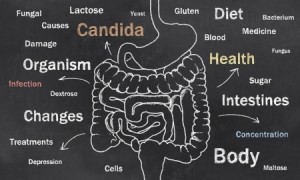Candida and Candidiasis Treatment
 Candida or Candidiasis results from the over-growth of a yeast-based fungus called Candida albicans. These yeast-based Candida cells are, in-fact, part of the normal flora of our bodies; these cells normally exist in the mouth, intestines, and other organs. When candida cells grow in an unbalanced manner, a number of health problems can result. Such health conditions include digestive disorders, fatigue, and vaginal yeast infections.
Candida or Candidiasis results from the over-growth of a yeast-based fungus called Candida albicans. These yeast-based Candida cells are, in-fact, part of the normal flora of our bodies; these cells normally exist in the mouth, intestines, and other organs. When candida cells grow in an unbalanced manner, a number of health problems can result. Such health conditions include digestive disorders, fatigue, and vaginal yeast infections.
Whether candidiasis is, strictly speaking, a disease or a syndrome is still somewhat controversial in Western medicine. In any case, the general public has accepted it as a valid disease and an important health concern. Although TCM does not have a strict diagnosis of “candidiasis,” there exists a clear framework and a treatment approach to candidiasis.
Candida is a very common problem in the United States. When you know the causes of candidiasis, it is not surprising that people are more prone to have it here than in other countries. There are a large number of medications that support the overgrowth of yeast-based cells; Some of these medications kill beneficial bacteria and others interfere with normal hormone functions. Some of these medications include: antibiotics, hormone replacement, corticosteroids, chemotherapy and oral contraceptives. In addition, improper diet, such as excess consumption of sugar, alcohol, or yeast products can promote yeast growth. According to traditional Chinese medicine, these foods disturb the balance of the Spleen, produce Phlegm, and create the perfect environment for yeast overgrowth.
According to TCM theory, balance of the whole is the most important principle for maintaining health. Yin and Yang, the opposites of the universe, also unite to form the basic structure and function of our bodies. These forces and substances must be in balance for us to be in good health. Likewise, maintaining the principles of balance is the same for the yeast cells and bacteria in our bodies: too many yeast cells, and a condition of candiadiasis results; too many bacteria, and infection can be present; when there is balance, we are in good health.
A Two-Step Treatment Plan with Chinese Medicine
Step 1. Cleansing
In Chinese medicine, a thorough cleansing is the first step in dealing with candidiasis. When our systems are full of the waste, phlegm and toxins which contribute to yeast overgrowth, clearing them out of the system is necessary. “The constitutional energy is endangered when an internalized evil is there,” says the Yellow Emperor’s Classic of Internal Medicine.
Many people try to clear out their yeast overgrowth with diet cleansing methods. For candidiasis, diet management alone is not strong enough to clear the system, or it can take a very long time. Combining proper diet with Chinese herbs and acupuncture can achieve this goal much faster. With herbal cleansing therapy, the goal is to clear the system of Dampness, Phlegm, and Heat. These are seen as the causative factors of candidiasis. The herbs are not intended to mechanically clear out the large intestine; rather, they promote the clearing-out of the pathological factors of Phlegm and Heat toxins. Commonly-used herbs include gentiana (long dan cao), melia (chuan lian zi), agastachis (huo xiang), cardamon (bai dou kou), saussurea (mu xiang), skullcap (huang qin), coptis (huang lian), and phellodendra (huang bai).
Step 2. Tonifying
After the waste, toxins, and phlegm have been cleared out of our systems, we then have to tonify our bodies, repairing the damage and restoring the balance, or the pathological factor(s) will return. “If sufficient vital energy exists, a pathological factor cannot attack us” (Yellow Emperor’s Classic of Internal Medicine). This is also a very important step to prevent recurrence of yeast infections. Commonly used tonifying herbs include astragalus (huang qi), codonopsis (dang shen), atractylodes (bai zhu), and dioscorea (shan yao). GI Strength Formula (Xian Sha Liu Jun Zi Tang) is a popular formula for tonification, especially of the Middle Burner.
A Recommendation for Your Diet
Most people will need to follow a yeast-free diet and stay away from bread, cheese, mushrooms, vinegar, soy sauce, barbecue sauce, black fungus, and white fungus. But there are other yeast-based foods such as crackers, pretzels, dry cereal, miso, tempeh, canned vegetables, pickled vegetables, beer, root beer and other fermented beverages which are often overlooked by those with yeast infections.
For most people, specific grains can be eaten while others (like gluten grains) will need to be eliminated for some months until the digestive system fully recovers. Rice, quinoa and buckwheat are generally the best tolerated grains, but some experimentation needs to be done as each person is different. Certain vegetables are extremely therapeutic for those with yeast infections, such as Daikon radish, which can help cleanse your system and is known as a “phlegm cleanser”.
The family of yellow-colored foods such as yam, winter squash, and pumpkins are strongly recommended from the viewpoint of traditional Chinese medicine, as they tonify and strengthen the Spleen and Spleen meridian.
If you would like additional information read our full description of candida.
Get started with a consultation today:
